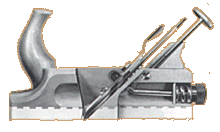More About ECE Primus Planes
The German woodworking tool tradition goes back as far as the English tradition,
but many woodworking tools developed differently. Wooden planes never fell out
of favor in Germany and even today are very popular. One distinguishing characteristic
of Continental European planes is the front horn you find on the shorter planes.
E.C. Emmerich Company (ECE), the makers of the Primus brand of wooden plane,
originally was founded in Remscheid, Germany in 1852 by Friedrich-Wilhelm Emmerich.
The company has always been family owned; now Hans-Joerg Emmerich is now the
fifth generation of the family to head the firm. The company has always been
successful, even had an English subsidiary in the  1930's.
But what most distinguishes ECE planes is the Primus adjustment mechanism for
wooden planes, invented in 1950 by Friedrich-Wilhelm Emmerich and father, Karl
Emmerich.. Prior to the Primus's invention, many firms attempted to add an adjuster
to a wooden plane, but no method was widely successful. Stanley, for example,
made a wooden plane with a regular metal frog because their adjuster required
the mechanism to be installed just behind the blade. Norris in the 1930's added
their patented mechanism to a wooden plane, but it still required loosening
the lever cap and fiddling (I am a major fan of Norris planes but not of their
adjusters). The Primus adjuster accomplishes all the main goals: The tensioning
mechanism in the blade is installed in a hole in the body that doesn't compromise
the dampening support a wooden blade bed gives the plane. The blade can be adjusted
without loosening tension so small adjustments can be easily made. Lateral adjustment
is precise for the same reason. And finally, the design can efficiently manufactured
in a modern factory, a feature that is very important in order to keep up the
quality. The result is a premium set of planes, with modern adjusters, made
to the finest of a long German tradition of toolmaking and craftmanship.
1930's.
But what most distinguishes ECE planes is the Primus adjustment mechanism for
wooden planes, invented in 1950 by Friedrich-Wilhelm Emmerich and father, Karl
Emmerich.. Prior to the Primus's invention, many firms attempted to add an adjuster
to a wooden plane, but no method was widely successful. Stanley, for example,
made a wooden plane with a regular metal frog because their adjuster required
the mechanism to be installed just behind the blade. Norris in the 1930's added
their patented mechanism to a wooden plane, but it still required loosening
the lever cap and fiddling (I am a major fan of Norris planes but not of their
adjusters). The Primus adjuster accomplishes all the main goals: The tensioning
mechanism in the blade is installed in a hole in the body that doesn't compromise
the dampening support a wooden blade bed gives the plane. The blade can be adjusted
without loosening tension so small adjustments can be easily made. Lateral adjustment
is precise for the same reason. And finally, the design can efficiently manufactured
in a modern factory, a feature that is very important in order to keep up the
quality. The result is a premium set of planes, with modern adjusters, made
to the finest of a long German tradition of toolmaking and craftmanship.
Another important design feature of Primus planes is the way the sole is attached to the body of the plane. Wooden planes have traditionally been made out of Beech. Beech is a wonderful wood, but it is sensitive to atmospheric changes and over time it will wear. The Primus solution is to attach a special sole, made from either Hornbeam or Lignum Vitae, to the beech body using a special machine cut surface joint. Both of these woods are more stable than beech and wear well (Lignum Vitae is the better performer), and the special joinery prevents the plane from ever coming apart. In addition, this type of construction leads to a natural extension of an adjustable mouth, a feature on some of the Primus planes that allows for both coarse and fine planing with the same tool.
Primus Planes are adjustable without a mallet:
- Small turn clockwise: thicker chip
- Small turn counter clockwise: thinner chip
Before leaving the factory, each PRIMUS Plane is tested. The control points are:
- Flawless plane body
- Carefully sharpened plane iron
- Absolutely tight fitting cap-iron
- Free flow of shavings
- Ease of adjustment
|
Hours: M-F 9:00-5:00, closed Sat,Sun Our Guarantee & Return Policy Shipping and Sales Tax Info Privacy Policy Holiday Calendar |
|
Contact Us:
Email: support@toolsforworkingwood.com Phone: 800-426-4613 or 718-499-5877 Visit Us in Brooklyn: Directions to Our Showroom © 1999-2019 toolsforworkingwood.com Powered by 01 Inc. Coded entirely in NYC |


